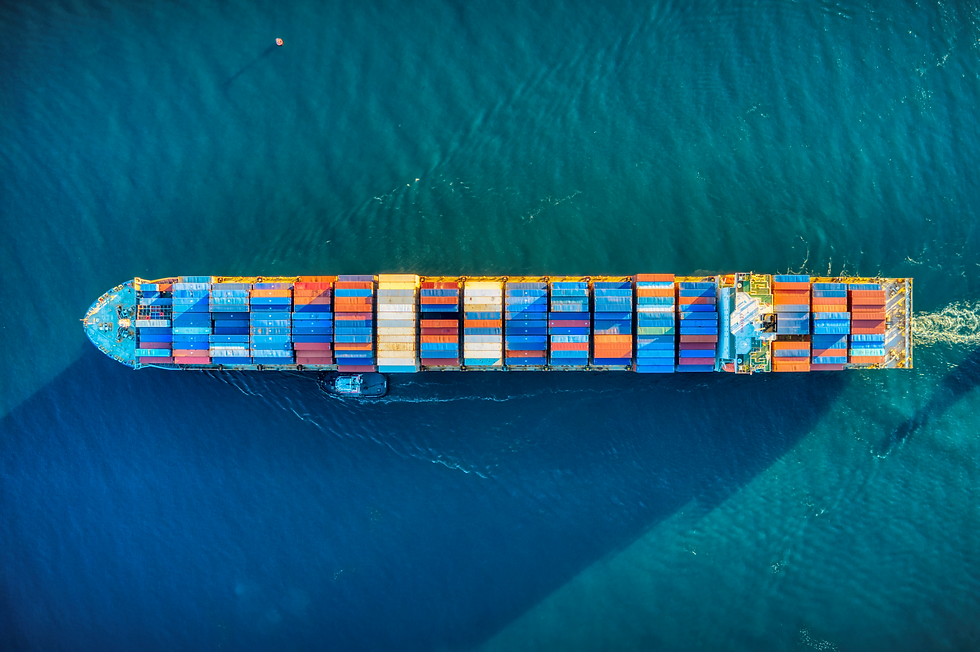How the shipping sector can be decarbonized by 2050
- Gryn

- Sep 19, 2023
- 4 min read
Updated: May 29, 2024
The shipping sector is a critical part of the global economy, responsible for transporting over 80% of global trade. However, the industry is also a heavy polluter, contributing to 3% of global greenhouse gas emissions. In recent years, there has been a growing recognition of the urgent need to decarbonize the shipping industry and reduce its environmental impact.
The International Maritime Organization (IMO) has been working towards reducing the industry’s greenhouse gas emissions, with their goal being to cut emissions from international shipping by at least half by 2050. Especially with maritime trade growing significantly and likely tripling by 2050, it is time for the industry to set its sights on carbon neutrality.
What can be done to decarbonize the shipping industry?
To achieve decarbonization by 2050, the shipping industry must take a comprehensive and holistic approach that includes technological innovation, operational efficiency improvements, and policy and regulatory measures.
Reporting and providing accurate emission data: Accurate and transparent reporting of emissions data is essential for the effective monitoring and management of the shipping industry's environmental impact. The International Maritime Organization (IMO) has an extensive Data Collection System, which requires ships to collect and report fuel consumption data, which will be used to in helping inform IMO measures to reduce emissions from ships. As for 2023, this data is used in a new measure of the operational carbon intensity of the ships. This will help incentivize ships to improve their carbon efficiency.
Technological innovation: New technologies can play a crucial role in reducing the shipping industry's carbon footprint. One of the most promising solutions is the use of alternative fuels such as hydrogen, ammonia, and biofuels. Several pilot projects are underway to test the feasibility of these fuels, and the industry is expected to scale up their use in the coming years. Another key technology is the development of electric and hybrid propulsion systems in ships, which will allow them to be run on these alternative fuels. This can significantly reduce emissions from ships.
Operational efficiency improvements: The shipping industry can also reduce its environmental impact by improving operational efficiency. This can include measures such as optimizing ship design, reducing speed, and improving logistics and supply chain management. Shipping companies can also adopt digital technologies such as artificial intelligence and digital twins to optimize operations and reduce waste.
Policy and regulatory measures: Governments and international organizations can play a critical role in incentivizing and regulating the shipping industry's decarbonization efforts. One example is the IMO's goal to reduce greenhouse gas emissions from the shipping industry by at least 50% by 2050 compared to 2008 levels. The European Union has also introduced regulations requiring ships to reduce their emissions when calling at EU ports. These policies and regulations can help incentivize ships to adopt low-carbon technologies and practices.
Predictions for the shipping industry in 2050
By 2050, the shipping industry is likely to look very different from today. While greenhouse gas emissions are expected to fall, international trade and the volume of global shipping traffic are expected to increase rapidly.
The IMO expects the shipping industry to grow up to 250% by 2050 and the main struggle for the shipping industry is how to achieve lower emissions with increasing growth. While global regulations for reducing emissions have huge potential to drive change in the shipping industry, many other factors will determine the success of decarbonization.
Pressing need to decarbonize: Many other social and political factors can impact the pressure on the shipping industry to decarbonize. The shipping industry needs to be looked at, not as a standalone industry, but as part of a global ecosystem. As such, factors such as consumer awareness and attitudes towards decarbonization, government regulations, oil prices, and many others will impact the speed at which the industry will decarbonize.
Ban of fossil fuels: The primary strategy for the shipping industry is to progressively but rapidly replace fossil fuels with renewable fuel forms, such as ammonia and advanced biofuels. However, if this conversion to alternative fuels does not happen quickly enough, there may be a need to implement a complete ban on fossil fuels in shipping, to force stakeholders to implement change.
Public pressure from society: As with most environmental policies, public pressure from individuals in society is a huge consideration in the implementation of regulations or lack thereof. If a majority of individuals support decarbonization and other environmentally friendly efforts, such successful implementation will be more encouraged and it will be easier to see progress.
In conclusion, the shipping industry's environmental impact is significant, but some steps can be taken to decarbonize the industry and reduce its greenhouse gas emissions. With the right incentives and investment, the shipping industry can play a crucial role in the transition to a low-carbon economy and help to mitigate the impacts of climate change.
gryn’s solution
With gryn, you can instantly share carbon emissions with thousands of customers. We handle the data validation, cleansing, standardization, and reporting. If your organization may not have existing carbon emissions data, the data can be calculated on gryn via leading connected providers (e.g. Searoutes, EcoTransit, TK Blue).
To find out more about gryn and how we can help your organization track its corporate carbon footprint, check out our website.




Comments